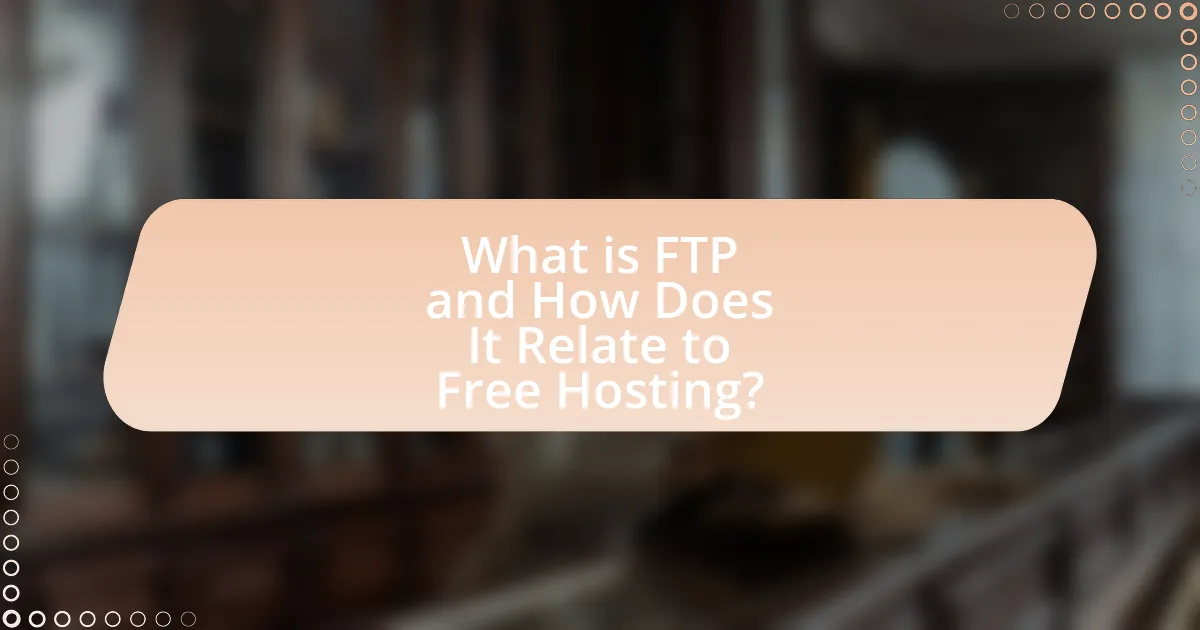FTP, or File Transfer Protocol, is a crucial tool for transferring files between a client and a server, particularly in the context of free hosting services. This article provides a comprehensive overview of FTP, detailing its functionality, key features, and the advantages it offers to users of free hosting platforms. It also explores the limitations of free hosting, the differences between free and paid hosting, and best practices for using FTP securely and efficiently. Additionally, the article outlines the steps to set up and connect to an FTP account, troubleshoot common issues, and manage files effectively, making it an essential guide for beginners looking to navigate the world of FTP and free hosting.

What is FTP and How Does It Relate to Free Hosting?
FTP, or File Transfer Protocol, is a standard network protocol used to transfer files between a client and a server over the Internet. In the context of free hosting, FTP allows users to upload and manage their website files on a server without incurring costs. Many free hosting services provide FTP access, enabling users to easily transfer files, update content, and maintain their websites. This functionality is essential for users who want to build and manage websites without the need for expensive hosting solutions.
What is FTP?
FTP, or File Transfer Protocol, is a standard network protocol used to transfer files from one host to another over a TCP-based network, such as the Internet. It enables users to upload, download, and manage files on remote servers. FTP operates on a client-server model, where the client initiates a connection to the server to perform file operations. The protocol has been in use since the early 1970s and is defined in several RFCs, including RFC 959, which outlines its specifications and functionalities.
How does FTP facilitate file transfers?
FTP, or File Transfer Protocol, facilitates file transfers by establishing a connection between a client and a server, allowing users to upload and download files over the internet. This protocol operates on a client-server model, where the client initiates the connection to the server, and commands are sent to manage file operations. FTP uses two channels: a command channel for sending commands and a data channel for transferring files, ensuring efficient communication and transfer processes. The protocol supports various authentication methods, including anonymous access, which enhances accessibility for users. Additionally, FTP can handle large files and multiple file transfers simultaneously, making it a robust solution for managing files on web servers.
What are the key features of FTP?
The key features of FTP (File Transfer Protocol) include the ability to transfer files between a client and a server, support for both binary and ASCII file types, and user authentication through usernames and passwords. FTP enables efficient file management by allowing users to upload, download, rename, delete, and move files on the server. Additionally, FTP operates over a reliable connection, ensuring data integrity during transfers, and can work in both active and passive modes to accommodate various network configurations. These features make FTP a widely used protocol for file sharing and management in web hosting environments.
What is Free Hosting?
Free hosting is a service that allows individuals or organizations to host their websites on the internet without incurring any costs. This type of hosting typically comes with limitations, such as reduced storage space, bandwidth restrictions, and the presence of advertisements on the hosted site. According to a report by HostingAdvice, many free hosting providers monetize their services through ads, which can affect the user experience.
What are the limitations of free hosting services?
Free hosting services have several limitations, including restricted storage space, limited bandwidth, lack of customer support, and the presence of advertisements. These services typically offer minimal disk space, often less than 1 GB, which can hinder the ability to host larger websites or applications. Bandwidth limitations can result in slow loading times or downtime during high traffic periods, as many free hosts impose strict data transfer caps. Additionally, free hosting often lacks reliable customer support, leaving users without assistance when issues arise. Furthermore, many free hosting providers display ads on users’ websites, which can detract from the site’s professionalism and user experience. These factors collectively make free hosting less suitable for serious projects or businesses.
How does free hosting differ from paid hosting?
Free hosting differs from paid hosting primarily in terms of features, reliability, and support. Free hosting typically offers limited storage, bandwidth, and lacks advanced features such as custom domain names, SSL certificates, and technical support, while paid hosting provides more resources, enhanced security, and customer service. For instance, many free hosting services display ads on user websites, whereas paid options allow for ad-free experiences, which is crucial for professional branding. Additionally, paid hosting often guarantees better uptime and performance, with many providers offering 99.9% uptime guarantees, ensuring that websites remain accessible to users.
Why Use FTP with Free Hosting?
Using FTP with free hosting is essential for efficient file transfer and management. FTP, or File Transfer Protocol, allows users to upload, download, and manage files on their web server easily. This is particularly important for free hosting services, which often have limited user interfaces for file management. By utilizing FTP, users can bypass these limitations, enabling bulk uploads and downloads, which saves time and effort. Additionally, FTP provides a more stable and reliable connection for transferring larger files compared to web-based file managers.
What advantages does FTP provide for free hosting users?
FTP provides free hosting users with efficient file transfer capabilities, allowing them to upload and download files quickly and securely. This protocol supports large file sizes, which is essential for users managing extensive website content. Additionally, FTP offers a user-friendly interface, making it accessible for beginners who may not have technical expertise. The ability to resume interrupted transfers is another significant advantage, ensuring that users do not lose progress during uploads or downloads. Furthermore, FTP allows for batch processing, enabling users to transfer multiple files simultaneously, thereby saving time and enhancing productivity.
How can FTP enhance the user experience on free hosting platforms?
FTP enhances the user experience on free hosting platforms by providing a streamlined method for file transfer and management. Users can easily upload, download, and organize files directly on the server, which simplifies website maintenance. This efficiency is particularly beneficial for those with limited technical skills, as FTP clients often feature user-friendly interfaces that allow drag-and-drop functionality. Additionally, FTP supports bulk file transfers, enabling users to move multiple files simultaneously, which saves time compared to web-based file managers. The reliability of FTP connections also ensures that file transfers are less prone to interruptions, further improving the overall user experience.

How to Get Started with FTP on Free Hosting?
To get started with FTP on free hosting, first, obtain your FTP credentials, which typically include a hostname, username, and password provided by your hosting service. Next, download and install an FTP client, such as FileZilla or WinSCP, which allows you to connect to your hosting server. After installation, open the FTP client and enter your credentials in the designated fields. Click “Connect” to establish a connection to your server. Once connected, you can upload and manage files on your hosting account. This process is standard across most free hosting providers, ensuring that users can easily transfer files to their web space.
What are the prerequisites for using FTP?
To use FTP, a user must have an FTP client software installed on their device. This software facilitates the connection to an FTP server, allowing file transfers. Additionally, the user needs valid login credentials, including a username and password, to access the server. A stable internet connection is also essential for successful data transmission. These prerequisites ensure that users can effectively manage files on their hosting accounts through FTP.
What software do you need to use FTP?
To use FTP, you need FTP client software. Popular FTP clients include FileZilla, WinSCP, and Cyberduck, which facilitate the transfer of files between your computer and a server. These applications support standard FTP protocols, ensuring secure and efficient file management. For instance, FileZilla is widely used due to its user-friendly interface and compatibility with multiple operating systems, making it a reliable choice for beginners.
How do you set up an FTP account with your free hosting provider?
To set up an FTP account with your free hosting provider, first, log into your hosting account’s control panel. Most free hosting providers offer a section for FTP accounts, often labeled as “FTP Management” or “FTP Accounts.” In this section, you can create a new FTP account by entering a username, password, and specifying the directory access level. After saving the settings, the FTP account will be created, allowing you to connect using an FTP client with the provided credentials. This process is standard across many free hosting services, ensuring users can easily manage their files.
How do you connect to your free hosting account using FTP?
To connect to your free hosting account using FTP, you need an FTP client, such as FileZilla or WinSCP. First, download and install the FTP client on your computer. Next, open the client and enter your hosting account’s FTP credentials, which typically include the server address, username, and password provided by your hosting service. After entering the details, click “Connect” to establish the FTP connection. This process allows you to upload and manage files on your hosting account efficiently.
What are the steps to establish an FTP connection?
To establish an FTP connection, follow these steps: First, download and install an FTP client, such as FileZilla or WinSCP. Next, open the FTP client and enter the server address, which is typically provided by your hosting service. Then, input your username and password associated with the FTP account. After entering these details, click on the “Connect” button to initiate the connection. Once connected, you can transfer files between your local machine and the server. These steps are standard for establishing FTP connections and are supported by most FTP clients.
What common issues might you encounter during connection?
Common issues encountered during connection include incorrect login credentials, firewall restrictions, and network instability. Incorrect login credentials, such as wrong usernames or passwords, prevent successful authentication, which is a frequent problem for users. Firewall restrictions can block FTP ports, typically port 21 for FTP and port 22 for SFTP, leading to connection failures. Network instability, including poor internet connectivity or server downtime, can disrupt the connection process, causing timeouts or errors. These issues are well-documented in user forums and technical support resources, highlighting their prevalence among FTP users.

What are the Best Practices for Using FTP with Free Hosting?
The best practices for using FTP with free hosting include ensuring secure connections, managing file permissions carefully, and regularly backing up data. Secure connections, such as using SFTP or FTPS, protect data during transfer, which is crucial since free hosting services may lack robust security measures. Managing file permissions prevents unauthorized access to sensitive files, as improper settings can lead to vulnerabilities. Regular backups safeguard against data loss, which is particularly important with free hosting, where data recovery options may be limited. Following these practices enhances security and reliability when using FTP with free hosting services.
How can you ensure secure file transfers using FTP?
To ensure secure file transfers using FTP, implement FTPS or SFTP protocols instead of standard FTP. FTPS adds a layer of security by using SSL/TLS encryption, while SFTP operates over SSH, providing a secure channel for data transfer. Both methods protect sensitive information during transmission, reducing the risk of interception. According to the Internet Engineering Task Force (IETF), using these secure protocols is essential for safeguarding data integrity and confidentiality during file transfers.
What security measures should you implement when using FTP?
To enhance security when using FTP, implement measures such as using SFTP (Secure File Transfer Protocol) or FTPS (FTP Secure), which encrypt data during transmission. These protocols protect sensitive information from interception, as standard FTP transmits data in plaintext, making it vulnerable to eavesdropping. Additionally, enforce strong password policies and regularly update passwords to mitigate unauthorized access risks. Implementing firewall rules to restrict FTP access to specific IP addresses further strengthens security by limiting exposure. Regularly monitoring logs for unusual activity can also help identify potential security breaches. These measures collectively create a robust security framework for FTP usage.
How does using SFTP differ from standard FTP?
SFTP, or Secure File Transfer Protocol, differs from standard FTP (File Transfer Protocol) primarily in its security features. SFTP encrypts both the command and data channels, ensuring that sensitive information is protected during transmission, while standard FTP transmits data in plain text, making it vulnerable to interception. This encryption in SFTP is achieved through the use of SSH (Secure Shell), which provides a secure channel over an unsecured network. In contrast, standard FTP does not offer any encryption, exposing user credentials and file contents to potential eavesdropping.
What are some common troubleshooting tips for FTP issues?
Common troubleshooting tips for FTP issues include checking your internet connection, verifying FTP server address and credentials, ensuring the correct port is used (usually port 21 for FTP), and confirming that your firewall or antivirus software is not blocking the FTP connection. Additionally, using passive mode in your FTP client can resolve connectivity problems, as some networks may restrict active mode connections. If you encounter permission errors, ensure that the user account has the necessary permissions to access the files or directories on the server. These steps are essential for diagnosing and resolving common FTP issues effectively.
How can you resolve connection errors?
To resolve connection errors, first ensure that your internet connection is stable and functioning properly. Check your network settings, including firewall configurations and router settings, as these can block FTP connections. Additionally, verify that you are using the correct FTP server address, username, and password, as incorrect credentials can lead to connection failures. If the issue persists, consider switching the FTP mode from passive to active or vice versa, as some networks may require one mode over the other. Lastly, consult your hosting provider’s documentation for specific troubleshooting steps related to their services, as they may have unique requirements or known issues.
What should you do if files are not uploading correctly?
If files are not uploading correctly, first check your internet connection to ensure it is stable and functioning. A weak or intermittent connection can disrupt the upload process. Next, verify that the file size does not exceed the limits set by your hosting provider, as many free hosting services impose restrictions on file sizes. Additionally, confirm that the file format is supported by the server; unsupported formats will fail to upload. If issues persist, consider clearing your browser cache or trying a different browser, as cached data can sometimes interfere with uploads. Lastly, consult the hosting provider’s support documentation or contact their customer service for specific troubleshooting steps related to their platform.
What are the best practices for managing files on free hosting via FTP?
The best practices for managing files on free hosting via FTP include organizing files into clear directory structures, regularly backing up data, using secure FTP protocols, and maintaining proper file permissions. Organizing files helps in easy navigation and retrieval, while regular backups protect against data loss, which is crucial given the limitations of free hosting services. Utilizing secure FTP protocols, such as SFTP or FTPS, ensures that data transfers are encrypted, safeguarding sensitive information. Additionally, setting appropriate file permissions prevents unauthorized access, enhancing security. These practices are essential for effective file management and security in a free hosting environment.
How can you organize your files effectively?
To organize your files effectively, create a clear folder structure that categorizes files by type, project, or date. This method allows for easy navigation and retrieval of files. For instance, using main folders for each project and subfolders for documents, images, and backups can streamline access. Research indicates that a well-structured file organization system can reduce time spent searching for files by up to 30%, enhancing productivity.
What file management techniques should you adopt for efficiency?
To enhance efficiency in file management, adopt techniques such as organizing files into clearly labeled folders, utilizing consistent naming conventions, and implementing version control. Organizing files into folders allows for quick access and retrieval, while consistent naming conventions help in identifying files easily. Version control systems, like Git, track changes and maintain a history of file versions, reducing the risk of data loss and confusion. These techniques are supported by studies indicating that structured file organization can improve productivity by up to 30%, as users spend less time searching for files.